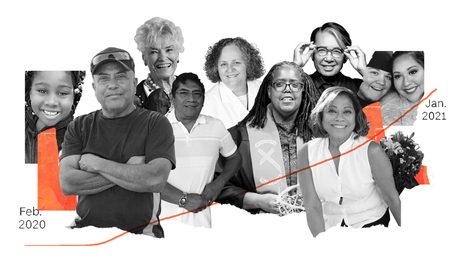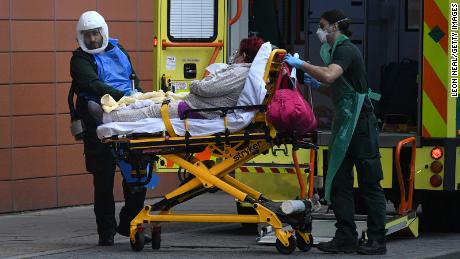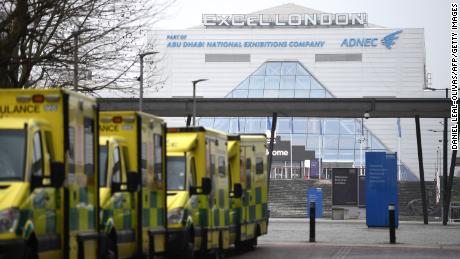For months, she says, a wave of depression had enveloped her, but she had been too busy saving other people’s lives to be able to identify it, or process it.
Instead she “shoved” her feelings down into a “dark part” of her brain. The stress manifested physically: She had constant headaches, a short fuse, and couldn’t eat, she said.
Fazilah remembers laying on her bathroom floor for three nights — each time after a grueling shift — where she said she dry heaved until she fell asleep.
“I hadn’t ate anything all night so what was going to come out? I fell asleep shortly after, only to be disturbed by those unacknowledged feelings in my dreams instead of when I was at work, because who had time to process anything in that soul-destroying place?”
Fazilah ultimately decided to stay at her job, but some of her colleagues did not, “simply due to what they have seen.”
1,182 people have died of Covid-19 in London alone.
Infection rates across the English capital — the epicenter of the UK’s current surge — are around 1.5 times higher than in other parts of England according to the latest government data. And nationwide, the outlook is grim.
killed more than 89,000 across the nation.
UK’s National Health Service (NHS) were stretched thin as they trained staff, converted wards into ICUs and, crucially, were forced to expand the “safe” NHS recommended nurse to patient ratio of 1:1 to 1:2, due to the sheer number of admissions.
are being pushed closer to the brink, as they treat more Covid-19 patients in hospitals than at any point in the pandemic.
A number of ICU workers CNN spoke to say they’ve been pushed to “dilute” the level of care due to the alarming surge of cases, saying that in many cases, they are treating far more than two patients at a time, and sometimes as many as eight.
None of them has been authorized by their respective hospitals to speak to the media, and so all have asked for some parts of their identity to remain anonymous.
Complex needs, complex care
Patients who are admitted to ICUs have incredibly complex needs and are often in multiple organ failure. ICU patients require highly trained nurses to care for them — specialists who are well-versed in treating their conditions through an array of technological interventions.
“When you have one nurse to one patient, you can give excellent care,” said one veteran ICU worker, who asked to remain anonymous.
They explained that because ICU patients are so sick and on ventilators, they require multiple drugs — which have to be closely monitored and changed regularly — to keep them asleep to keep their blood and heart pumping. Plus, they might also be on a dialysis machine, a “demanding” piece of equipment to filter a patient’s blood.
Nurses also need to closely monitor heart rates and blood pressure, they added, and if something starts to drop, they might have to change the mechanical ventilation filter.
“You can imagine if the nurse has to do that much for now four patients, then things are going to potentially get missed,” they said, stressing that patients in ICU are now sicker then they were in the pre-pandemic.
“That nurse really needs to be with that one patient,” they said.
government data.
Ameera Sheikh, an ICU nurse and Unite union representative at a London hospital, told CNN that instead of one patient — or even two — she and her colleagues are now each looking after up to eight patients at a time.
It’s a situation that not only compromises the level of care for the sick, but also adds to the stress and well-being of the health care workers providing it.
“Nurses aren’t able to deliver the care we are used to and should be giving,” said Sheikh, who has been working for the NHS for 11 years. “Instead we are increasing the risk of errors occurring that can lead to patients deteriorating, life-threatening situations and death.”
Sheikh explained that medics without a critical care background had been redeployed to the ICU to help, but as they haven’t been through specialized training, ICU nurses are also having to train and teach them on the job.
A spokesperson for the NHS in London told CNN in a statement that: “The NHS has well-established plans in place to cope with additional demand and maintain patient safety.” The statement added that: “Nursing staff ratios can be flexed to cope with pressure as appropriate and where it is safe to do so.”
On Sunday, NHS chief executive Simon Stevens told the BBC’s Andrew Marr Show that the nurse to patient ratio varied between hospitals from 1:1 to 1:2 to 1:3, and that staff are making “dynamic adjustments in real time.”
He said that “patients are being looked after,” but that “the key point has got to be, unless the coronavirus infection rate is under control, then here, just as in every other country in the world … these services will remain under severe pressure.”
with about 94,000 full-time roles unfilled — many of them in nursing and midwifery.
said that there were nearly 14,000 more nurses working in the NHS than the previous year. The Chair of the British Association of Critical Care Nurses refuted that number,
saying that that there was “no evidence” of those nurses in the NHS.
The pressures of the second wave have only amplified those shortages, nurses say.
Some have moved out of their homes to be closer to hospitals in order to work more shifts — and to protect their families, Sheikh explained, adding that even on off days, it’s almost impossible to switch off.
“Guilt suddenly rushes in because you aren’t at work helping. Nurses are receiving WhatsApp messages multiple times a day to work flexible shifts on their time off,” she said. “That’s how desperate ICUs are.”
Hospitals, staff ‘under extreme pressure’
The veteran ICU healthcare worker, who works at a different London hospital, told CNN that Covid-19 patients are coming in with critically low levels of oxygen every day.
Patients are entering the emergency room terrified, she said, explaining that such low levels of oxygen can make you “feel like you are being suffocated.” Medics will first attempt to get oxygen levels up with an oxygen mask and by using non-invasive ventilation, but if that doesn’t work then patients will need to be put into a medically-induced coma and onto a ventilator.
That procedure is fairly routine for doctors, they explained; however, low oxygen levels can make it riskier and in some cases, lead to cardiac arrest.
“What is difficult about this [situation] is trying to manage it all at once,” the nurse said. They said that this horrifying scenario is often unfolding for multiple patients at the same time, across hospital wards that are not set up for critical care, as the ICUs are already at full capacity.
37,400 Covid-19 patients in UK hospitals. Last Tuesday, there were 4,534 new admissions — the highest number of daily admissions so far in the pandemic.
Stevens said that he wasn’t going to “sugar coat” the facts, saying on Sunday that hospitals and staff are “under extreme pressure.”
He said that in England a new person is admitted to hospital every 30 seconds. He said that the NHS had never been in such a precarious position in its 72-year history.
reported that ICU units in London were already running at 114% occupancy, forcing them to stretch capacity, and that requests had been made by hospitals there to send critical care patients to hospitals in Yorkshire, more than 200 miles to the north. Stevens confirmed on Sunday that a “small number” of patients had been transferred from one region to another.
converting spare hotel rooms into recovery wards.
accountable for the mess. They say that delayed lockdowns and fumbled messaging around Christmas all contributed to the surge, and have added to public frustrations.
On Monday, a government spokesperson told CNN: “Our approach has always been guided by scientific and medical advice. As soon as we became aware that the new variant transmits more easily, we significantly reduced the Christmas relaxations and introduced stay-at-home restrictions where it was most prevalent.”
“As the Prime Minister has said, we are seeing some early signs of progress, but we continue to monitor the data and keep restrictions under review.”
Sheikh said she was aware of videos purportedly showing empty hospital corridors and a hospital coffee shop making their way across social media. But patients aren’t kept in coffee shops nor in hospital corridors, she said, adding that maintaining patients’ dignity and privacy is at the forefront of all care.
“These people haven’t seen the inside of an ICU and haven’t had difficult conversations with families about withdrawing life [support] because we’ve done everything in our power to sustain it,” Sheikh said of the conspiracy theorists.
At a press conference with the Prime Minister earlier this month, Stevens condemned the videos and the people who continue to wrongly claim that the pandemic is not real.
“If you sneak into a hospital — in an empty corridor at nine o’clock at night — and film that particular corridor, and then stick it up on social media and say, ‘This proves the hospitals are empty, the whole thing is a hoax’, you are not only responsible for potentially changing behavior that will kill people, but it is an insult to the nurse coming home from 12 hours in critical care, having worked her guts out under the most demanding and trying of circumstances,” he said.
“There’s nothing more demoralizing than having that kind of nonsense spouted when it’s most obviously untrue.”
A ‘constant carousel’
While health care workers try to shrug off the people spreading misinformation, many nurses say it does affect morale. Plus, the surge in cases means that planned or elective surgeries are being postponed.
Fazilah, the ICU nurse in central London told CNN that she wishes that people could see how much effort and patience it takes to navigate through a day in full PPE without “wanting to shout at someone because you’re so tired and frustrated, and your workload is tripled.”
“The burden of having three patients is immense,” she said, explaining that Covid-19 patients add an additional element of unpredictability, as they can shift from being stable to being in cardiac arrest “out of nowhere.”
“If one of my three patients suddenly deteriorates, I feel horrifically guilty … thinking ‘Why didn’t I see that coming?’ or ‘What could I have done to prevent it?’ — when in reality I could have done nothing,” Fazilah said, adding that “It’s extremely difficult” to leave those shifts to rest.
“When you’re back the next day … all you’re worrying about is their family and how would you feel if that was your loved one.”
Not being able to switch off can be frightening, Fazilah said, adding that when a patient dies, there is often little time to grieve before the next patient arrives in the ward.
“It’s like you’re on a constant carousel and you can’t get off,” she said.
study found that a large proportion of intensive care unit staff surveyed in the UK
have reported symptoms of post-traumatic stress disorder (PTSD), anxiety or depression, and some feeling they would be better off dead.
For some nurses, having to help families say goodbye to their relatives remotely, since they unable to do so in person, has contributed to that trauma.
Fazilah described the “horrific” experience of having to hold up a tablet to a dying patient’s ear so their family members could speak to them.
“The impact of that and imagining that it could be you saying bye to your parents or loved ones, is so much more damaging than people realize,” she said. “And it stays with you.”









